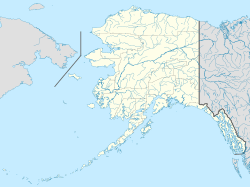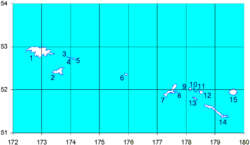Buldir Island facts for kids
Buldir Island is a small, remote island in the western Aleutian Islands of Alaska, a U.S. state. It is about 4.3 miles (6.9 km) long and 2.5 miles (4.0 km) wide. The island covers an area of about 7.4482 square miles (19.291 km2).
Buldir is special because it is farther from other land than any other Aleutian Island. Its closest neighbors are Kiska (68 miles to the east) and Shemya (64 miles to the west). No one lives on Buldir Island today. It is part of the Alaska Maritime National Wildlife Refuge, which helps protect its natural environment.
Contents
Island Formation: Geology of Buldir
Buldir is one of the youngest islands in the Aleutian chain. It was formed by volcanoes. The rocks on the island come from two different periods of volcanic activity.
Volcanoes and Coastline
The island has two main volcanoes. The Buldir Volcano makes up most of the island and is its highest point, reaching 2,152 feet (656 m) tall. The East Cape Volcano forms the northeast part of the island.
Buldir Island does not have a natural harbor. Its coast is mostly made of steep cliffs or rocky beaches. There is only one small, flat area called North Bight Beach. This spot is on the northwest shore and is the only place where small boats can land safely when the weather is good.
Human History on Buldir Island
People lived on nearby islands like Shemya and Kiska as far back as 2000 B.C.E. Because Buldir is located between these two larger island groups, it's possible that ancient travelers stopped there.
Early Inhabitants and Discoveries
Archaeologists visited Buldir several times between 1991 and 2001. They found proof that people lived on the island off and on for over a thousand years. The wet clay on the island helped preserve old wooden tools and other items. This allowed scientists to figure out when people lived there.
Scientists studied a large ancient trash pile, called a midden, at North Bight Beach. This midden showed what the early people ate. They found bones from 23 different kinds of birds, mostly seabirds. They also found bones from mammals, mostly Steller sea lions, and fish.
The Steller's Sea Cow Mystery
Among the bones, archaeologists found a rib from a Steller's sea cow. This animal was a relative of today's manatees. It became extinct in 1768 because Russian fur traders hunted too many of them. This was one of the first times evidence of Steller's sea cow was found outside of Russia's Commander Islands. The rib was about 1,600 years old.
Archaeologists believe people did not live on Buldir Island all the time. Sometimes people came from the Near Islands, and sometimes from the Rat Islands. It's not clear why early people risked the dangerous journey to Buldir. Some think they might have been forced to move due to a lack of food on their home islands. Another idea is that Buldir was a neutral meeting place for different groups.
Archaeologists found a large house built with whale bones from the 1600s. The size of this house and other discoveries suggest that people lived on Buldir for longer periods, not just passing through.
European Discovery
The recorded history of Buldir Island began in 1741 with Vitus Bering's Second Kamchatka Expedition. Bering's ship, the St. Peter, was sailing back to Russia when many crew members became sick with scurvy. On October 28, 1741, a sailor named Stephen Buldirev died. Later that day, they saw land, which scholars believe was Buldir Island. Bering named it "St. Stephen Island." However, by 1787, it appeared on Russian maps as Buldir. It's thought that the island was named after the sailor who died.
Buldir Island in World War II
In June 1942, Japanese forces took over Attu and Kiska islands, which are near Buldir.
Reconnaissance and Weather Station
The U.S. military flew planes over Buldir in late 1942 and early 1943. They wanted to see if the Japanese were on the island and to gather weather information.
After the U.S. won the Battle of Attu in May 1943, the Japanese secretly left Kiska in July 1943. Some U.S. officers thought the Japanese might have used Buldir as a meeting point to escape, but this was not true.
In October 1943, a five-person team from the United States Army Air Corps set up a weather station on Buldir. Their job was to report weather conditions every hour and help guide planes. It was hard to get supplies to them because of the difficult landing conditions, so supplies were often dropped by air from Kiska. The weather station closed in 1945 when the war ended.
Incidents During the War
On March 3, 1944, Corporal Carl E. Houston walked away from the weather station and was never seen again. In 1988, scientists found a skeleton with Army boots and a rifle. It was identified as Corporal Houston, but how he died is still unknown. He was the only person to die on the island during World War II.
On February 2, 1945, Lieutenant Arthur W. Kidder, Jr., was flying a Lockheed P-38 Lightning plane. His radio broke, and he couldn't find his base on Attu. Running low on fuel, he spotted Buldir and made an emergency landing. Kidder was only slightly hurt. The weather station team radioed for help, and he was rescued two days later. Kidder's crashed plane was later used for target practice. In 1994, the plane was recovered, restored, and is now on display at the Hill Aerospace Museum in Utah.
Post-War Buldir
In October 1956, a tanker ship called the Dulcinea ran aground on Buldir. It was carrying a lot of aviation fuel and was lost.
Since 1988, the United States Fish and Wildlife Service has had teams on Buldir during certain seasons. They study the seabirds that nest there. Their research helps manage the ocean's resources and fisheries in the region.
Amazing Bird Life
Buldir Island is very special for birds. Because it is so remote and hard to reach, Russian and American fur traders never brought Arctic or red foxes to the island. Foxes were brought to many other Aleutian islands, where they ate bird eggs and chicks. Buldir also avoided having rats introduced.
A Safe Haven for Seabirds
Because there were no foxes or rats, ground-nesting birds on Buldir could live safely. This made Buldir one of the largest and most diverse seabird breeding colonies in the Northern Hemisphere. During breeding season, about 4 million seabirds of 21 different species live on the island.
The island is home to many birds, including crested auklets, least auklets, puffins, and storm petrels. It is also one of only four places where red-legged kittiwakes breed. In 2019, over 116 different bird species had been seen on Buldir. Many rare Asian bird species have also been recorded there because of its closeness to Asia.
The Cackling Goose Success Story
Buldir played a very important role in saving the Aleutian subspecies of Cackling Goose. This type of goose was thought to be extinct by the early 1900s. Foxes and rats had eaten their eggs and goslings, causing their numbers to drop.
In 1962, a small group of about 300 Cackling Geese was found on Buldir Island. These geese survived because there were no predators like foxes or rats on the island. In 1967, the bird was listed as endangered.
To help the geese recover, young goslings were taken from Buldir Island for a special breeding program. The new geese were then released onto other Aleutian Islands where foxes had been removed. This recovery plan worked! The Aleutian cackling goose was removed from the endangered species list in 2001. By 2017, there were possibly as many as 150,000 of these geese, most of them descended from the original Buldir Island population.




